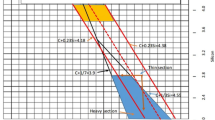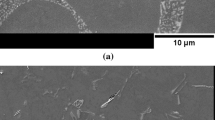Abstract
This paper will present results of a thorough evaluation of the effects of (1) ‘plain’ thermal analysis (TA) cup (aka ‘eutectometer’ cup, as coined by Heine in AFS Trans 78:187–193, 1970; AFS Cast Metals Res J 7:49–54, 1971; AFS Trans 80:462–470, 1973) design/geometry (square vs. round), (2) ‘before’ and ‘after’ paper cup inoculation of plain TA cup, (3) inoculant type, and (4) inoculant dosage on the resultant TA metrics and microstructure characteristics as quantified by image analysis metallography of treated and inoculated ductile iron. Since production castings have near-infinite shapes and sizes, there is often a large variation in the types and dosages of inoculants employed by ductile iron casting producers. Thus, the evaluations of this paper are important in quantifying the proportions of gage variation (discriminating capability) for all independent and interactive combinations of the foregoing four predictor variables. That is, the gauge variation for any combination of predictor variables must be sufficiently low to make any valid assessment(s) of them having significant effects on the responses of TA metrics and microstructure characteristics. Further analysis was done in probing for any significant correlations between TA metrics and the ultrasonic velocities and quantified microstructure characteristics of both mold-cooled and water-quenched coupons after casting, with presentation of results for the significant correlations. When GR&R variation for the effects of any combination of all the TA predictor variables is sufficiently low, we can then make valid assessment(s) of their effects on and correlations to ultrasonic velocity and digital metallographic image analysis metrics of test coupons that were cast simultaneously with TA cups in multiple sets cast from a single sample spoon.



















Similar content being viewed by others
Change history
23 April 2022
The Keywords have been updated by correcting the description of one of the plain thermal analysis (TA) cup types.
19 September 2023
A Correction to this paper has been published: https://doi.org/10.1007/s40962-023-01158-8
26 October 2023
A Correction to this paper has been published: https://doi.org/10.1007/s40962-023-01184-6
References
R.W. Heine, The Fe-C transformation diagram related to solidification of cast irons. AFS Trans. 78, 187–193 (1970)
R.W. Heine, The carbon equivalent Fe-C-Si diagram and its application to cast irons. AFS Cast Metals Res. J. 7(2), 49–54 (1971)
R.W. Heine, Carbon, silicon, carbon equivalent, solidification, and thermal analysis relationships in gray and ductile cast irons. AFS Trans. 80(73–82), 462–470 (1973)
J. Cree, I. Grybush, M. Robles et al., Statistical comparisons of four (4) different thermal analysis sample cup types for chemistry control of ductile base iron. Inter. Metalcast. 15, 729–746 (2021). https://doi.org/10.1007/s40962-020-00498-z
ASTM E2567-16a. Test method for determining nodularity and nodule count in ductile iron using image analysis; ASTM International: West Conshohocken, PA (2016). Available online: www.astm.org
ISO 945-4:2019. Microstructure of cast irons – Part 4: test method for evaluating nodularity in spheroidal graphite cast irons; International Organization for Standardization: Geneva, Switzerland (2019). Available online: www.iso.org
O.M. Suarez, C.R. Loper Jr., Influence of thermal analysis cups on assessment of critical temperatures during cast iron solidification. AFS Trans. 106, 929–937 (1998)
C.R. Loper Jr., R.W. Heine, R.W. Reesman, B.H. Shah, Thermal analysis of ductile iron. AFS Trans. 75, 67–41 (1967)
R.W. Heine, C.R. Loper Jr., Characterization and interpretation of ductile iron cooling curves. AFS Trans. 79, 399–410 (1971)
R.W. Heine, Carbon silicon, carbon equivalent, solidification, and thermal analysis relationships in gray and ductile cast irons. AFS Trans. 82, 462–470 (1974)
M.D. Chaudhari, R.W. Heine, C.R. Loper Jr., Principles involved in the use of cooling curves in ductile iron process control. AFS Trans. 82, 431–440 (1974)
E.F. Ryntz, J.F. Janowak, A.W. Hochstein, C.A. Wargel, Prediction of nodular iron microstructure. AFS Trans. 79, 141–144 (1971)
M.D. Chaudhari, R.W. Heine, Potential applications of cooling curves in ductile iron process control. AFS Trans. 82, 379–386 (1974)
M.D. Chaudhari, R.W. Heine and C.R. Loper, Jr., Principles involved in the use of cooling curves in ductile iron process control. AFS Cast Metals Res. J. 1975, pp. 52-60
D.R. Askeland, S.S. Gupta, Effect of nodule count and cooling rate on the matrix of nodular cast iron. AFS Trans. 83, 313–320 (1975)
J. van Eegham, G. Devos, J. Plessers and O. Cure, Application of thermal analysis in the iron foundry – progress and recent developments. AFS Int. Cast Metals J. 1977, pp. 57-63
R. Monroe, C.E. Bates, Thermal analysis of ductile iron samples for graphite shape prediction. AFS Trans. 90, 307–311 (1982)
J. Torrance, C. Misterek, V. Popovski, Verification of the dynamic nature of thermal analysis properties in ductile iron. AFS Trans. 117, 607–616 (2009)
P. Zhu, R.W. Smith, Thermal analysis of nodular cast iron. AFS Trans. 104, 601–609 (1996)
D.M. Stefanescu, Thermal analysis—theory and applications in metalcasting. Inter Metalcast 9, 7–22 (2015). https://doi.org/10.1007/BF03355598
T. Kanno, Y. Iwami, I. Kang, Prediction of graphite nodule count and shrinkage tendency in ductile cast iron, with 1 Cup thermal analysis. Inter. Metalcast. 11, 94–100 (2017). https://doi.org/10.1007/s40962-016-0111-x
M.N. Bhat, D.M. Afzal Khan, K.K. Singh, Thermal analysis and graphitization ability of spheroidal graphite cast iron preconditioned by Al, Zr, Ca–FeSi. Inter. Metalcast. 13, 928–936 (2019). https://doi.org/10.1007/s40962-019-00311-6
D.A. Sparkman, Microstructure by thermal analysis. AFS Trans. 119, 413–420 (2011)
J. Cree, M. Robles, A. Hoover et al., Ductile iron front-end ultrasonic nodularity determination using standard coupons. Inter. Metalcast. 14, 861–893 (2020). https://doi.org/10.1007/s40962-019-00322-3
E.A. Lange, R.W. Heine, Effects of melting furnace atmosphere on casting properties and annealability of malleable iron. AFS Trans. 61, 107–130 (1953)
C.R. Loper, Jr., P.S. Nagarsheth and R.W. Heine, Nodule counts and ductile iron quality, fourth annual ductile iron conference, Gray Iron Founders’ Society: Madison, WI, Aril 8-9, 1964
R.W. Heine, Nodule count: the benchmark of ductile iron solidification. AFS Trans. 101, 879–884 (1993)
ASTM A247-67 (original). Standard test method for evaluating the microstructure of graphite in iron castings; ASTM International: West Conshohocken, PA (1967). Available online: www.astm.org
ISO 945-1:2008 (original). Microstructure of cast irons – Part 1: graphite classification by visual analysis; International Organization for Standardization: Geneva, Switzerland (2008). Available online: www.iso.org
D. Franzen, B. Pustal, A. Bu¨hrig-Polaczek, Influence of graphite phase parameters on the mechanical properties of high silicon ductile iron. Inter. Metalcast. (2022). https://doi.org/10.1007/s40962-022-00761-5
T. Noguchi, K. Nagaoka, Three- dimensional distribution of graphite nodules in spheroidal graphite cast iron. AFS Trans. 93, 115–122 (1985)
J.F. Wallace, P. Du, H.-Q. Su et al., The influence of foundry variables on nodule count in ductile iron. AFS Trans. 94, 813–834 (1986)
D.M. Stefanescu, R.J. Warrick, L.R. Jenkins et al., Influence of the chemical analysis of alloys on the nodule count of ductile iron. AFS Trans. 94, 835–848 (1986)
R.E. Ruxanda, D.M. Stefanescu, T.S. Piwonka, Microstructure characterization of ductile thin wall iron castings. AFS Trans. 110, 1–17 (2002)
S. Komatsu, T. Shiota, K. Nakamura, H. Kyogoku, Relation between microstructure size and ductile-brittle transition behaviour in fracture toughness of ferritic nodular cast iron. Adv. Mater. Res. 4–5, 189–194 (1997)
C. Labrecque, P.-M. Cabanne, E.C. Muratore, Ductile iron characteristics and impact strength at low temperature. AFS Trans. 118, 233–242 (2010)
F. Unkic, Z. Glavas, K. Terzic, Influence of nodule count on toughness of ferritic ductile iron. Strojarstvo 50(4), 231–238 (2008)
Acknowledgments
The authors thank Jason Black of Heraeus Electro-Nite for his assistance in navigating the intricacies of HEN’s thermal analysis software. We also thank the Grede – New Castle Melt Department and Laboratory Technicians Gary Bray, Herbert McGhee, and David Todd for their assistance.
Author information
Authors and Affiliations
Corresponding author
Ethics declarations
Conflict of interest
The authors declare that they have no conflict of interest.
Additional information
Publisher's Note
Springer Nature remains neutral with regard to jurisdictional claims in published maps and institutional affiliations.
Supplementary Information
Below is the link to the electronic supplementary material.
Rights and permissions
Springer Nature or its licensor (e.g. a society or other partner) holds exclusive rights to this article under a publishing agreement with the author(s) or other rightsholder(s); author self-archiving of the accepted manuscript version of this article is solely governed by the terms of such publishing agreement and applicable law.
About this article
Cite this article
Cree, J., Hoover, A. Statistical Comparisons & Correlations of Thermal Analysis, Ultrasonic Velocity and Image Analysis Metallography Methods for Quantification of Ductile Iron Microstructure. Inter Metalcast 17, 54–81 (2023). https://doi.org/10.1007/s40962-022-00778-w
Received:
Accepted:
Published:
Issue Date:
DOI: https://doi.org/10.1007/s40962-022-00778-w
Keywords
- GR&R
- thermal analysis
- cooling curve
- 5th-derivative
- round plain (‘RD-PL’) vs. square plain (‘SQ-PL’) thermal analysis (TA) cups
- inoculant type and amount
- ultrasonic velocity
- FEUNDUSC
- water-quenched
- mold-cooled
- digital image analysis metallography
- ‘particle count’ vs. ‘area’ nodularity ratings
- INclusionary vs. EXclusionary nodule count




